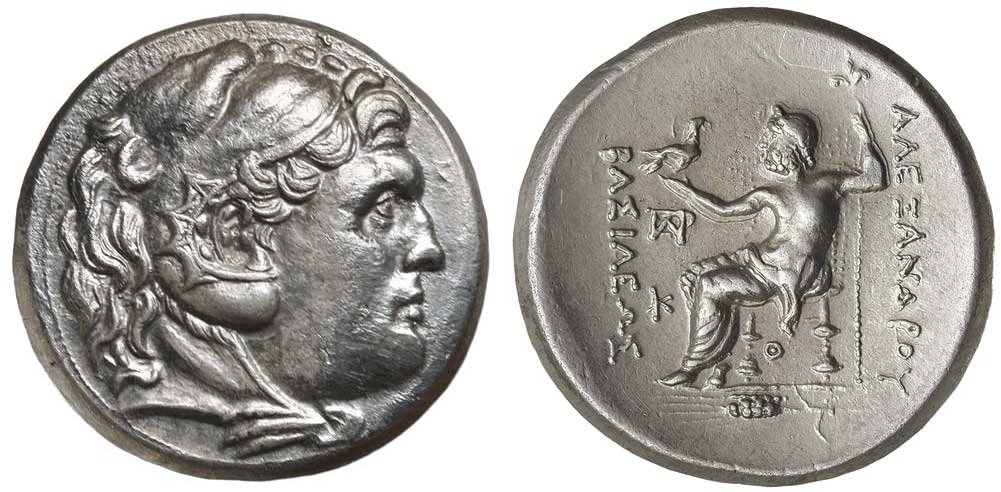S 1068 - Callatis (Alexander the Great), silver, tetradrachms (250-225 BCE)
From SILVER
250 BCE - 225 BCE Silver 3,369 kg
Description
| ObverseInscription or printing placed on the obverse.: | Head of Herakles to right wearing lion skin with dotted border |
| ReverseInscription or printing placed on the reverse.: | ΒΑΣΙΛΕΩΣ ΑΛΕΞΑΝΔΡΟΥ (Greek).Zeus Aetophoros seated on throne to left, eagle in outstretched hand, monogram over K in left field, monogram under throne, corn ear in exergue |
Mint and issuing power
| MintIdentifies the place of manufacture or issue of a numismatic object.: | Callatis | Ancient regionAncient region.: | Thrace | Modern countryModern country: Romania | AuthorityIdentifies the issuing power. The authority can be "pretended" when the name or the portrait of X is on the coin but he/she was not the issuing power. It can also be "uncertain" when there is no mention of X on the coin but he/she was the issuing power according to the historical sources: | Alexander III the Great (Argead king, 336-323 BC) |
Chronology
| FromIdentifies the initial date in a range assigned in a numismatic context. | 250 BCE | toIdentifies the final date in a range assigned in a numismatic context.. | 225 BCE | PeriodTime period of the numismatic object.: Hellenistic 323-30 BC |
Physical description
| MetalThe physical material (usually metal) from which an object is made.: | Silver |
Median weightMedian of the weights of numismatic objects (in grams). in grams | 17.1 | DenominationTerm indicating the value of a numismatic object. Examples: tetradrachm, chalkous, denarius.: | tetradrachm |
StandardStandard.: | Attic |
Image

RQEM ad. 1068 - Callatis, silver, tetradrachm, 250-225 BC.jpg [1]
References
| Die study referencePublication of the study: | Marinescu - Lorber 20121Marinescu - Lorber 2012, p. 199-201 | ||
| Coin series referenceReference to coin series study: | |||
| Coin series web referenceCoin series web references: |
| ||
Obverse dies distribution
| FrequencyFrequency of specimen in distribution. ᵖ | Number of obversesNumber of obverse dies. ᵖ (o) | % (o) | Number of coinsNumber of coins. (n) | % (n) | Die nameName(s) of the die(s). |
| 1 | 3 | 33.33 | 3 | 6.12 | |
| 2 | 2 | 22.22 | 4 | 8.16 | |
| 8 | 1 | 11.11 | 8 | 16.33 | |
| 11 | 2 | 22.22 | 22 | 44.9 | |
| 12 | 1 | 11.11 | 12 | 24.49 | |
| Total | 9 of 9 | 99.99 | 49 of 49 | 100 |
Reverse dies distribution
no distribution is available
Quantification
| Number of obversesNumber of obverse dies. ᵖ (o) | 9 | Number of singletons (o1)The number of singleton coins. ᵖ | 3 |
| Number of reverse diesNumber of reverse dies. (r) | 23 | Number of coinsNumber of coins. (n) | 49 |
| Coins per obverse dieNumber of coins per obverse die. (n/o) | 5.44 | Coins per reverse dieNumber of coins per reverse die. (n/r) | 2.13 |
| Reverse per obverse ratioRatio of obverse dies divided by reverse dies. (r/o) | 2.56 | Percentage of singletons (o1)number of coins (n) divided by the number of singletons (o1) ᵖ | 33.33 % |
| Original number of dies (O) (Carter 1983 formula)The estimation of the number of coins according to Carter 1983 ᵖ | 9.85 | Coins struck if 20,000 as average productivity per dieCoins made if the average productivity for obverses (according to Carter) is 20,000. ᵖ | 197,000 |
| Original number of dies (O) (Esty 2011 formula)The estimation of the number of coins according to the singleton formula in Esty 2011 ᵖ (O) | 11.03 | Survival rate if 20,000 as average productivity per dieSurvival rate if average productivity is 20,000. ᵖ | 0.00025 |
| Coverage (o = % of O) (Esty 1984 formula)Esty 1984 - coverage (% of O) ᵖ (o = % of O) | 93.88% | Die productivity if survival rate 1/2,000Average productivity if survival rate is 1/2,000. ᵖ | 9,949.24 |
| Weight of silver (in kg) if 20,000 coins per die (O = Carter formula)Carter 1983 * Median weight * 20000 (*10 if gold or electrum) ᵖ | 3,369 kg <br /> 3,369 kg | Die productivity if survival rate 1/5,000Average productivity if survival rate is 1/5,000. ᵖ | 24,873.1 |
Remarks
Most likely one single workstation